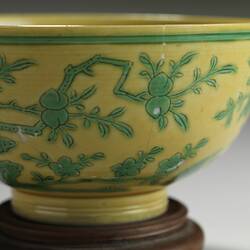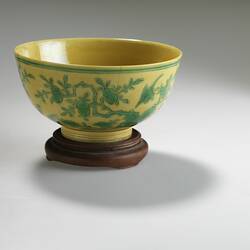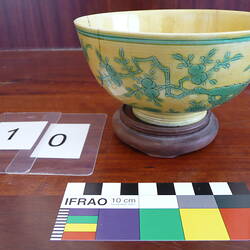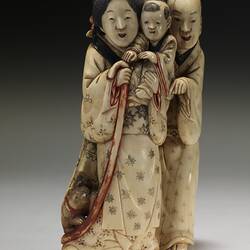Summary
Porcelain bowl with painted enamel decoration in the 'famille jaune' palette with green fruit trees on a yellow background and wooden stand, manufactured in China during the late Qing Dynasty (1644-1911), Daoguang period, 1821-1850.
In the early eighteenth century in Jingdezhen in the Jiangxi Province, a town with a long established history of ceramic production, a decorative style of overpainting the base glaze in enamels developed called 'famille rose', or 'soft colours', and was known in Chinese as 'fencai'. The style incorporated a broader palette of colours than had previously been used, allowing for items of more complexity to be depicted.
In the nineteenth century, a variation of this ornamental style developed that used coloured enamels painted over a yellow ground, called 'famille janue'. This porcelain bowl, decorated in the 'famillie jaune' palette, carries the mark of the eighth Emperor of the Qing Dynasty, Emperor Daoguang (1820-1850) on the underside.
Only three exhibitors displayed ceramic ware under Class 20, Pottery, in the Chinese Court at the 1880 Melbourne International Exhibition, but the comparisons made against examples of ceramics on display in the Japanese Court were particularly unfavourable. As the Official Record of the Exhibition noted: 'The exhibit of porcelain was very indifferent, and although a few of the vases were old and rare, neither the shape nor the designs were delicate or choice'.
In part, such negative views reflected broader social and political issues relating to the Chinese population in Australia at the end of the nineteenth century. While Japan had only relatively recently opened to Western trade in a substantial way in 1868, and was seen as new, cultured and refined, China was regarded as producing items of inferior quality and standard. It was a view not always supported by the quality of the exhibits at the Exhibition.
Physical Description
Deep round bowl on circular wooden stand. Yellow background decorated with green fruit trees and birds. Simple wooden foot with three low feet. Lots of breaks that have been glued back together.
More Information
-
Collection Names
-
Collecting Areas
-
Acquisition Information
Cultural Gifts Donation from Dr Will Twycross, 23 Jan 2009
-
Acknowledgement
Donated through the Australian Government's Cultural Gifts Program
-
Place & Date Made
-
Place & Date Exhibited
Royal Exhibition Building (REB), Melbourne, Greater Melbourne, Victoria, Australia, 1880-1881
-
Collector
Mr John Twycross, Elsternwick, Greater Melbourne, Victoria, Australia, 1880
-
Inscriptions
Signed on underside of bowl's foot in black 'hanzi' (Chinese characters) with the mark of the Daoguang period (1821-1850), denoting the reign of the Emperor Daoguang (October 1820-February 1850). da qing dao/ guang nian zhi (lit. Big Qing Daoguang year made) Reading from right to left, top to bottom, it translates as: Made in the Daoguang year [reign] of the Great Qing [Dynasty].
-
Classification
Royal exhibition building, International exhibitions, Exhibition heritage
-
Category
-
Discipline
-
Type of item
-
Overall Dimensions
125 mm (Width), 60 mm (Height)
-
Maximum dimensions
65 mm (Height), 124 mm (Outside Diameter)
Measurement From Conservation.
-
Keywords
Chinese Art, Decorative Arts, Exhibitions: Melbourne International, 1880-1881, Royal Exhibition Building





